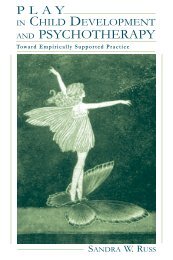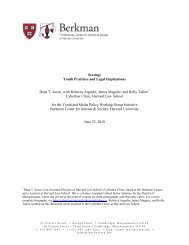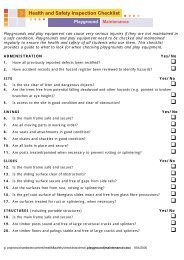Download PDF - Fair Play For Children
Download PDF - Fair Play For Children
Download PDF - Fair Play For Children
Create successful ePaper yourself
Turn your PDF publications into a flip-book with our unique Google optimized e-Paper software.
55.<br />
In addition to the above policy, guidance and play space provision the FC have been promoting<br />
play through den building events, play days and through its active woods programme<br />
http://www.forestry.gov.uk/forestry/INFD-6ACE8M.<br />
<strong>Play</strong> and the natural environment<br />
56.<br />
There is now a body of evidence which shows the benefits of play in the natural environment:<br />
•l contact with the natural environment promotes imaginative and social play;<br />
•l playing in a natural environment improves children’s social, mental and physical<br />
development, with some evidence of less bullying behaviour and better concentration at<br />
school 41 ;<br />
•l children use the natural environment to recover from stress and this helps to reduce mental<br />
health disorders 42 ;<br />
•l children are more likely to maintain high levels of physical activity when they play<br />
outdoors 43 ; and<br />
•l playing in the natural environment provides opportunities for young people to experience,<br />
assess and cope with modest risks (eg deciding whether to jump over a stream) and so helps<br />
counter the play limiting effects of a risk averse culture 44 .<br />
57.<br />
Natural England’s aim is that every child in England should have the opportunity to enjoy and<br />
experience the local natural environment to benefit their mental and physical health as well as<br />
their social development. Action includes:<br />
•l making more and regular use of the outdoor natural environment within play, sport and<br />
Surestart programmes;<br />
•l expanding programmes such as forest schools where the outdoors becomes the classroom<br />
(and providing relevant skills for teachers via changes to the curriculum for teacher training);<br />
•l greening of school grounds to include natural features;<br />
•l more nature-based play opportunities provided in green spaces, with less dependence on<br />
expensive factory made play equipment and more emphasis on low-cost natural features<br />
such as slopes, trees and water games and activities;<br />
•l better networks of green routes and places for everyone to use which in turn provide safer<br />
places for young people to play;<br />
•l planners requiring high quality, informal, small scale natural play areas in new residential<br />
developments which are well designed to encourage safe and regular use; and<br />
41 Fjortoft, I & Sageie, J 2000. The natural environment as a playground for children. Landscape and Urban Planning Vol 48, 83-97.<br />
42 Wells NM, Evans GW; Nearby Nature; A buffer of life stress among Rural <strong>Children</strong>. Environment and Behaviour, vol.35, No 3 311-330 2003.<br />
43 Baranowski T, Thompson WO, DuRant RH, et al. (1993) Observations on physical activity in physical locations: age, gender, ethnicity, and month<br />
effects. Res Q Exerc Sport; 64:127-33<br />
44 The Gulbenkian Foundation<br />
72 <strong>Fair</strong> <strong>Play</strong>: A consultation on the play strategy



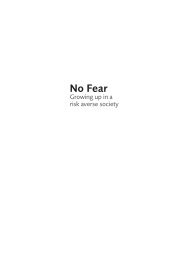
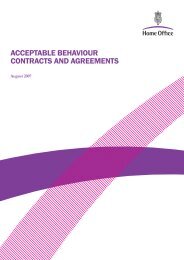
![The Childcare Act 2006 - Notes [Website] - Fair Play For Children](https://img.yumpu.com/50144819/1/184x260/the-childcare-act-2006-notes-website-fair-play-for-children.jpg?quality=85)




![Bouncy Castles [PDF] - Fair Play For Children](https://img.yumpu.com/45463572/1/184x260/bouncy-castles-pdf-fair-play-for-children.jpg?quality=85)

